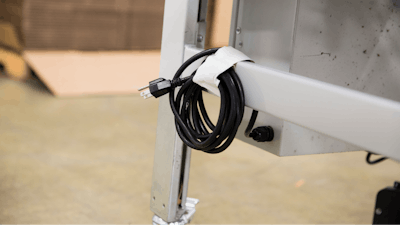
On-the-spot problem solvers, Maintenance, Repair and Operations (MRO) teams know how to resolve issues quickly by depending on a core set of tools to expedite common tasks. Two tools frequently found within easy reach are masking tape and duct tape, and while you may think you already know what to do with these tapes, some of their more creative uses may surprise you — and save you time.
To help MRO teams improve organization and efficiency and keep production moving, our Shurtape Industrial team has gathered some tape tips from the field to add to your workday arsenal. You’ll also learn which tape works best for each use so you know when to reach for the beige roll and when to grab the gray one.
Masking Tape: Made to Order
Masking tape’s name suggests a singular purpose, but it doesn’t have to stick solely to masking tasks. With a paper backing that provides a ready writing surface, masking tape is convenient for labeling
items on the fly. Masking tape is also easy to tear, so a roll can turn into your own customized label dispenser for organizing countless items.
Some popular items that masking tape can label and organize include:
- Personal tools and protective equipment
- Storage drawers and bins
- Personnel lockers
- Supply room shelves
- Boxed items
- Charging cords
- Break room items
- Outlets and switches
Using masking tape for labeling organizes workspaces and supplies so you and your personnel can quickly locate items to complete tasks efficiently.
 Shurtape
Shurtape
Color Quickly Communicates
Taking labeling with masking tape to the next level, some MRO pros have added color-coding to their organizational strategies with tapes like Shurtape’s CP 631 General Purpose Colored Masking Tape. This product comes in 12 different hues, providing plenty of options for assigning colors to item categories for quick communication.
For example, you can label storage bins containing screws with blue masking tape and those containing nails with yellow masking tape. Then, you can further identify each bin’s contents by writing the type of screw or nail on the tape. When you enter the supply room looking for nails, your eyes go directly to the yellow-labeled items, and your search time is reduced. This same organizational method can be applied in other areas, too, such as color-coding tools and equipment according to use or marking items for different shifts.
Flagging Fixes
Another clever way MRO pros use masking tape is to flag areas in need of maintenance or repair. Using red masking tape, for example, a technician can mark the location where a repair is needed. The tech can then retrieve the proper tools or parts and return them right to the spot or send another service technician to the precise location later by directing them to the area marked with red tape.
Standard beige masking tape can also be used for this purpose. You can write part numbers and instructions on the tape for quick reference. A quality masking tape will deliver up to 14 days of clean removal, providing plenty of time to tend to the task.
Upside Down or Right-Side Up? Tape Can Tell.
A common mishap when performing maintenance and repair tasks is installing a part upside down. To prevent positioning problems, apply a piece of masking tape to the part and draw an arrow on it to indicate which way the part should be installed. You can also place a piece of tape on the equipment for further clarity. This simple hack saves time and prevents unnecessary frustration. Plus, it’s ideal for everyday maintenance items like filters and protective panels.
HVAC filters, for example, typically include arrows that indicate airflow direction, but a novice maintenance person may not know how that translates to an air handling unit. Placing a piece of tape on the unit in the area where the filter gets inserted is a quick, easy reminder and ensures the equipment is properly filtering air.
 Shurtape
Shurtape
When You Need Things to Go Your Way
Many facilities have recently expanded to increase production, leaving MRO teams the responsibility of directing personnel safely around construction zones. Instead of purchasing signs, take the masking tape you would have used to hang signs and use it to direct your personnel. Simple tape arrows on walls or floors can get people where they need to go. You can also make fast changes to directions if your construction area moves. And if you need to direct different groups of people, you can use a different tape color for each group.
 Shurtape
Shurtape
For These Final Tips, Gray Is the Way
The last two quick tape tips from MRO pros in the field call for tougher stuff: duct tape.
Duct tape has some key features that make it better suited for more demanding MRO work. First, duct tape has a more aggressive adhesive, so it delivers a stronger stick to a wider variety of materials. Second, it has a cloth backing that’s sealed with a waterproof film. This allows it to stretch, flex and twist around objects like broken pipes and awkwardly shaped parts while delivering strength for tasks like sealing, repairing, holding and waterproofing.
Common uses aside, two new, creative uses for duct tape recently popped up in the area of equipment repair. Here’s what we found.
- Wicked-easy wire pulling. By placing a piece of duct tape on the end of a wire and folding it over, you can create a long, strong, stays-stuck tab that is easier to grip by hand or tool than the bare wire. This sure beats the old grip-and-slip.
- Tiny screws take a seat. Equipment screws have gotten smaller and smaller. When you remove them to make a repair, it’s anybody’s guess how many will make it back. Next time, tear off a piece of duct tape and place it sticky side up on a nearby work surface. Then, you’ll have a safe place to put those micro screws so they stick around.
Ideas That Stick
Undoubtedly, masking tape and duct tape will continue to offer new, unexpected uses like these that make MRO work easier. The low cost of these tools and their everywhere-all-at-once presence means each new discovery will feel like a small win in the big battle for greater organization and efficiency.
For more information, visit www.shurtape.com.























